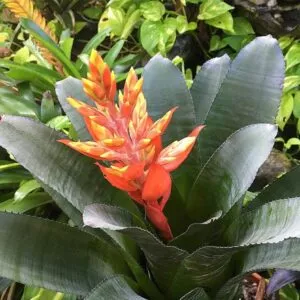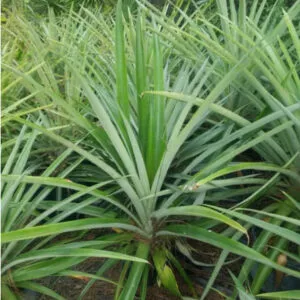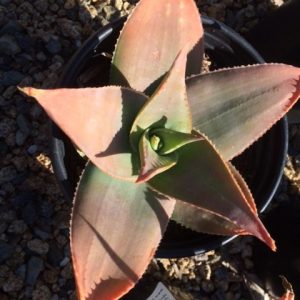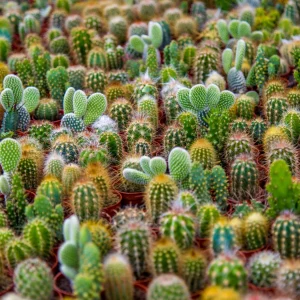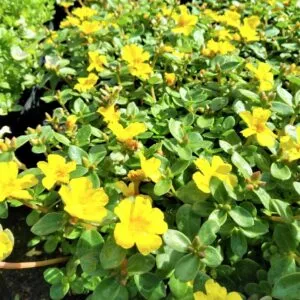No products in the cart.
Table of Contents
The calathea varieties make for some of the best indoor plant species and are always on the list when buying houseplants.
A fact is you will take one look at the elaborate foliage and fall in love with it. You can find many Calathea varieties available to choose from.
Each one has its personality that you will love.
Calathea Plants
Regardless of the variety of Calatheas you choose, Calathea Care needs similar problem-free growth.
They need well-draining soil kept moist, high humidity in warm environments, and bright indirect sunlight with monthly feeding.
One thing is for sure you will fall in love with the types of Calathea varieties available for you here. Each has unique features, from light green leaves, purple foliage, and long green stems to even a distinctive pattern.
So keep reading and get ready to be amazed.
Most Popular Calathea Varieties
Now, brace yourself for a journey through tropical forests with these gorgeous Calathea varieties we have lined up here for you.
Calathea orbifolia

The Calathea orbifolia boasts an exquisite appearance with its large and patterned leaves. Each round leaf is designed with pale silver-green stripes on its light green foliage. Due to the size of its foliage, this indoor plant is also known as a round-leaf calathea or orbifolia prayer plant.
For a more defined variegation, the plant requires bright, indirect light. It prefers a warm temperature and a high humidity level. So, make sure that you keep the plant misted. Keep the soil damp but avoid overwatering.
You must agree this Calathea variety leaves look metallic, right? Ohh, yes; also, keep it away from drafty places and too much direct sunlight that can cause brown edges on the leaves.
Check the detailed Calathea orbifolia plant care guide for more tips on growing this gorgeous plant.
Calathea roseopicta dottie

Also called rose-painted calathea, the dark green foliage of this plant is adorned with beautiful white, green, and hot pink tones.
When the plant folds up at night, you’ll observe that the leaf’s underside is a flashing color of burgundy. So, this plant is a natural beauty back to back.
Rose-painted calathea originates from Northwest Brazil. To keep this calathea healthy, it needs exposure to bright, indirect light.
The soil must be consistently wet but not soggy, so provide a well-draining potting mix. If you want to invest in this beautiful variety, you can find the Calathea reseopicta Dottie in our shopping list.
Calathea roseopicta ‘Rosey’

As with the previous Calathea variety, the Rosey is also attractive. In the center of the plant, you find a pink color. Instead of long green stems, it is hot pink, and the oval-shaped leaves have nearly purple undersides and hues.
Another notable thing about the foliage is the dark green edges. Its growing requirements are the same as other varieties of Calathea roseopicta.
Remember to provide diffused light so the leaves will remain vibrant in color with the top and deep purple foliage.
Calathea warscewiczii

If you’re having trouble pronouncing Calathea warscewiczii, we suggest you call it Jungle Velvet Calathea instead.
These terms point to the same species of plant anyway. As its common name suggests, this species’ stunning foliage has a velvet underside. Conversely, the surface is variegated with a light green pattern at the center of the medium green leaves.
The surrounding edges are bright green. This plant will thrive indoors; provided there’s plenty of humidity. Those velvety leaves will flourish if they receive enough moisture.
As for light requirements, it prefers to have bright indirect sunlight.
-
Free Shipping$21.99Sold By: Gar-Zen Botanical Design
Only 3 left in stock (can be backordered)
Red Brazil Bromeliad Aechmea nudicaulis
Only 3 available and it’s in 2 people’s basketRated 4.86 out of 5 based on 49 customer ratings00Sold By: Gar-Zen Botanical Design -
$28.64 – $59.95Sold By: Carlo's Plant Farm
In stock
Pineapple Florida Special | Carlo`s Plant Farm
Rated 5.00 out of 5 based on 22 customer ratings00Sold By: Carlo's Plant Farm -
$22.00Sold By: Cacti and Exotica
In stock
Senecio rowleyanus—String of Pearls
Rated 4.98 out of 5 based on 59 customer ratings00Sold By: Cacti and Exotica -
$45.99Sold By: Succulent Oasis
In stock
Mature Aloe Hybrid | Aloe Striata Hybrid or Ghost Aloe | A beautiul purple-gray Aloe
Rated 4.84 out of 5 based on 352 customer ratings00Sold By: Succulent Oasis
Calathea makoyana “Peacock plant”
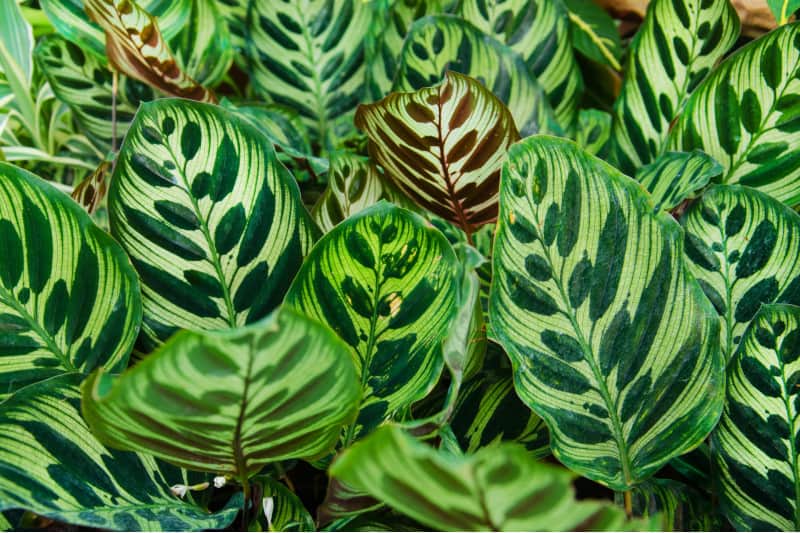
The exciting thing about Calathea makoyana is that its fabulous foliage is heavily patterned with oval shapes of emerald green.
This pattern closely resembles the one you see in peacocks. So, it is no surprise that it is called Calathea makoyana peacock plant. Some people call it the peacock plant.
Avoid placing Calathea makoyana under direct sunlight, which will damage the dense foliage. Keep it well-watered, and provide high humidity to keep the deep green leaves looking great.
It would be ideal to group this with other tropical plants. So check out the peacock plant to make it part of your family at home. The peacock calathea will not disappoint you.
.
Calathea ornata

If you fancy plants with stripe variegations, then pinstripe calathea is for you. The dark green leaves with oval shapes have a pattern with small white stripes on the surface. Like the other calathea species, it boasts purple undersides.
The calathea ornata pinstripe will be a stunning addition to your office or home. What makes Calathea ornata unique is the presence of light pink stripes on its dark green leaves. These stripes are why this species is commonly called a pin stripe plant.
The color is solid and dark purple at the back of the foliage. This calathea can grow up to 2 feet in height and width. It makes a perfect potted plant indoors. Bright indirect sunlight is ideal for its growth.
Make sure to provide plenty of moisture through regular watering and humidity. Luckily we have you covered with a detailed Calathea ornata plant care guide.
So you will not go wrong caring for this beauty.
Calathea zebrina

Another calathea plant that bears striking foliage is the Calathea zebrina or zebra plant. It is called such because the stripes present in its light green foliage resemble that of a zebra.
The stripes may be white or yellow, and they appear to be feather-like. Zebra plant has long stalks. Avoid placing the plant under overly wet conditions, which may lead to root rot.
This is the usual cause of casualty among zebra plants, so be careful. Make sure that the soil is well-draining. Provide consistent misting and partial shade.
Calathea ornata ‘Sanderiana’

Another variety is the Calathea ornata Sanderiana. It has dark green leaves that are large, elliptical, and glossy. The stripes have pink overtones on their surface, while the back boasts deep purple undersides.
The growing requirements of this plant are just the same as that of other Calathea varieties.
Calathea ‘Fusion White’
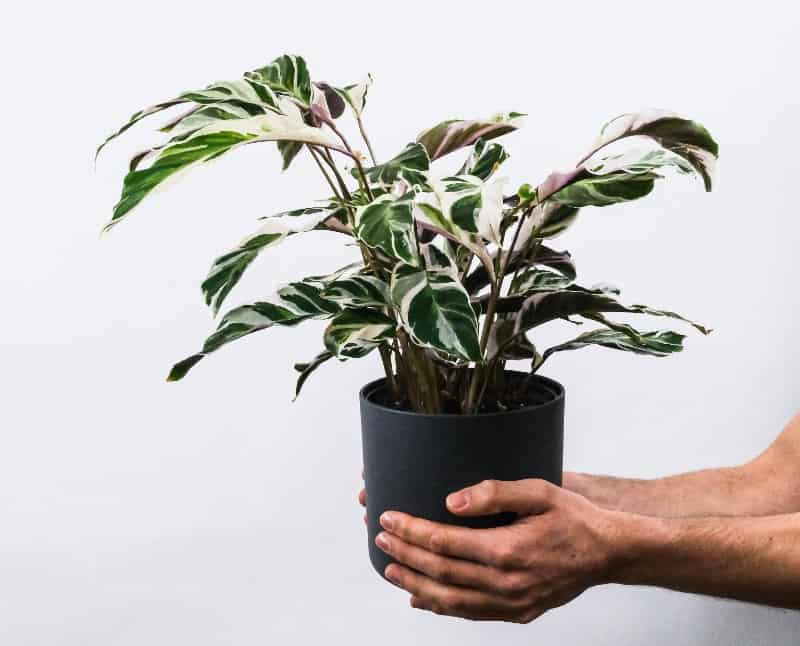
Calathea white fusion is unique among the calathea genus. The variegations of white, green, and lilac make up the color of its foliage. The plant is magnificent and is a valuable addition to your household.
Place it indoors, and it will make a striking appearance. With a glance, the foliage looks like bright green feathering.
Place the white fusion under bright but indirect light to keep the variegation vibrant. A warm environment with high humidity is a lovely place for this calathea.
When the top 2 inches of the soil gets dry, provide water.
Calathea albertii ‘White Tiger’
Calathea albertii, famous as White Tiger, is strongly similar to the White Fusion. They both have striking variegations of white, light pink, and green.
The difference relies on the pattern of its variegation, as the white markings in White fusion are more prominent.
Still, the white tiger is a rare plant not easily found to buy. This plant needs partial shade, too, to show off those beautiful colors. Like the other calathea plants, the White tiger needs high humidity.
Calathea ‘Beauty Star’

Calathea Beaty Star is definitely a real beauty. Once glance and you’ll surely be captivated by its vivid leaf patterns. The foliage is upright with feather-like stripes. They make an elegant attraction to any home with dazzling colors of white and pink. The purple undersides are also prominent.
Keep the soil evenly moist and bring it under bright filtered light. Humidity levels higher than 60% are most preferred.
Calathea roseopicta ‘Medallion’

Characterized for having large, oval, and patterned leaves, the Calathea medallion is another plant for keeps. On top of each dark-colored leaf is a light green border or outline while the center has a feather-like pattern. The leaves, however, have deep purple undersides.
This outdoor plant gets happy with medium to bright, indirect light. The temperature must be warm, between 65-85oF. Of course, it requires high humidity as well so make sure it receives regular mist.
Calathea lancifolia

Calathea lancifolia has lance-shaped leaves adorned with dark green oval shapes or dots. It’s also known as a rattlesnake calathea because it offers a wild attraction when added inside a room.
The rattlesnake plant is quite showy and stunning, and its leaf edges are somehow corrugated. This calathea doesn’t want to dry out, so give water regularly.
Otherwise, you’ll observe leaf curling when the plant gets dehydrated. Keep it in a well-lit area with indirect exposure to light.
Calathea rufibarba

Nothing stands out more for an indoor tropical feel than the Calathea rufibarba with elaborated marked foliage. The common name is velvet calathea or furry feather.
It is a Brazilian native that has a compact plant form with clumping upright growth. The spear-like foliage displays dark green leaves with burgundy undersides.
Even calathea care is not complex, and the Calathea rufibarba thrives in warm indoor environments and cannot handle cold drafts.
Keep your plant in bright indirect sunlight and keep the soil moist but not soggy.
Calathea crocata Eternal Flame
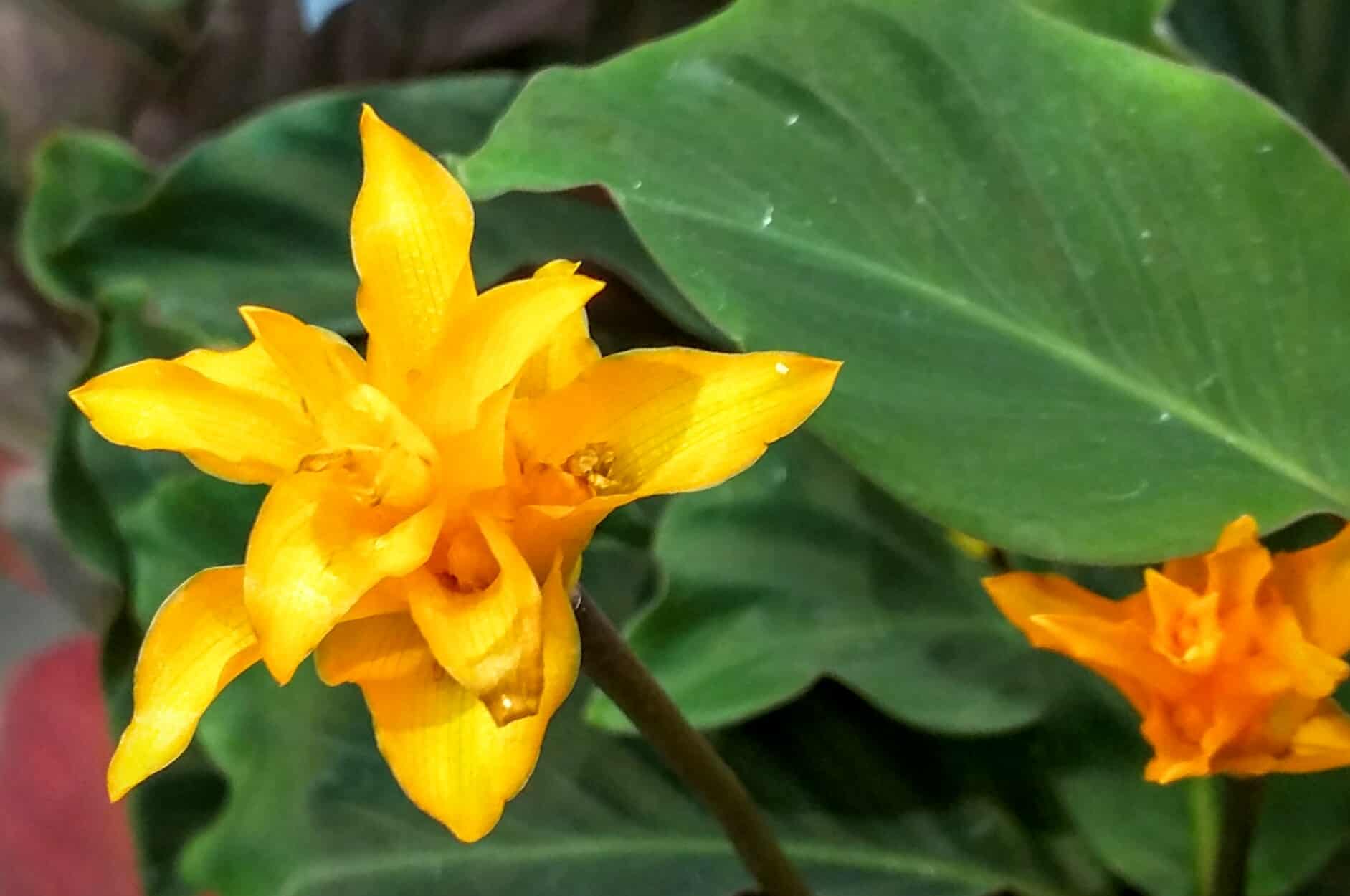
The eternal flame is a newcomer to the calathea varieties as it has bright flowers. Unfortunately, the plant becomes more challenging to find due to environmental damage in Brazil.
Each bloom lasts up to three months, but the dark green leaves also put on an amazing display. The plant prefers it warm and humid with regular watering. Neither does it tolerate direct sun.
Final Thought
With such a vast expanse of choices, you’re probably overwhelmed by what species or variety of calathea to acquire.
Don’t let this throw you. Choose the one that best suits the growing requirements you have at home and the type of design you wish to achieve at home.
Head out to Plantly and check our available calathea plants in our marketplace. We offer the best!
Frequently Asked Questions
The calathea varieties belong to the prayer plant family recognized by the patterned foliage with round leaves in light green or dark green with burgundy undersides or purple.
The calathea white star, known as Calathea majestic white star, is a unique species. The leaves are larger than other varieties and are white instead of the dark green leaves found on most plants.
The calathea white fusion is a fussy plant with its white variegation making photosynthesis difficult. It is also picky out of the humidity levels it stands.
Calathea plants prefer bright, filtered light to stand in the sun. Too much direct sunlight can cause leaf burn and color fading on the plant.
The calathea plants need warmth to thrive, standing in bright indirect light away from the sun. It helps to keep the soil moist and provide humidity by misting the leaves daily or grouping them with other humidity-loving plants.
You can keep a calathea plant indoors or outside in the garden. Still, they do not tolerate frost and must be brought indoors during winters in freezing temperatures.
Whether you want to buy, sell, or simply reach out to other plant enthusiasts, Plantly is the right place to be!
-
Free Shipping$8.96Sold By: CZ Grain
In stock
Cacti Seeds Mix – 50 Seeds – Cactus Species Mix – Ships from Iowa, USA – Grow Exotic Succulent Cacti
Only 900 available and it’s in 2 people’s basketRated 4.60 out of 5 based on 156 customer ratings00Sold By: CZ Grain -
$65.00Sold By: Via Citrus
$75.00In stock
Meyer Lemon Citrus – Indoor/Outdoor Citrus
Only 93 available and it’s in 5 people’s basketRated 4.92 out of 5 based on 237 customer ratings76Sold By: Via Citrus -
Free Shipping$17.99Sold By: Gar-Zen Botanical Design
In stock (can be backordered)
Purslane “Lemon Drops” Edible Herb Ships Free.
Only 22 available and it’s in 1 people’s basketRated 4.86 out of 5 based on 49 customer ratings00Sold By: Gar-Zen Botanical Design -
$34.99Sold By: Succulent Oasis
$40.99In stock
Large Bonsai ‘Money Tree’ Plant
Only 5 available and it’s in 1 people’s basketRated 4.84 out of 5 based on 352 customer ratings00Sold By: Succulent Oasis
